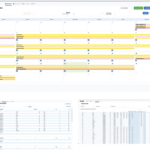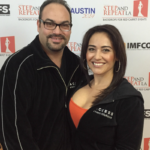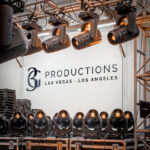Like a few others, Hermann Fruhm imagined lights moving. Unlike others, he took a wholly unique approach to the proposition, and after nearly three decades of gestation, his vision of a truss rig that moves lights is coming to fruition.
While the idea was hatched before the Vari*Lite burst on the scene, that development only enhanced the appeal and possibilities as now his “Ferris wheel” rigging approach can move moving lights making it more exciting. Also the ability for a lighting designer to move lasers, cameras, and projectors is now possible with a Parasol system. (See “Product Spotlight,” PLSN, Aug. 2011).
The Vancouver, BC-based company launched a new branding campaign, a new website, and is aggressively working to grow its North American market as it builds on some pretty high-profile successes already (American Idol, Disneyland, a tour with one of Italy’s most popular singer/songwriters, etc.). Most recently, there is their STAR600, the more affordable plug-and-play version of their idea of increasing the visual artist’s palette.
Backstory
When Fruhm left high school in 1967, he played music full time until 1980, and in 1973 was signed to the Warner Brothers label and had an album produced by Phil Ramone. But playing live, he noticed those typical eight PAR cans hanging on that truss and wondered aloud if there wasn’t some way of getting them to move.
“In the old days, big bands would take 8,000 PAR cans out, and I’m looking at that and wondering if there isn’t some way to bolt them to the truss and have the truss move so you’d need less lights,” he says. The idea of a Ferris wheel hit him, as did the ideal of a universal drive where the trussing would cause all the lights to tilt, pan, and sway.
In 1992 he drove to an LDI trade show on a reconnaissance mission, repeating this process every few years. Meanwhile, an inventor and entrepreneur at heart, in 1994 he created Megapro, a multi-bit screwdriver that became a multi-million dollar business for him. Around the time of his screwdriver company launch, he got so far as to create a computer-generated simulation of his moving truss idea (which he proudly still has on one of those 3.5-inch floppy disks, if you’re old enough to remember what those were).
Their first unit was named “SkyTrain” after the Vancouver rapid transit system, he tells with a laugh. “It was large and bulky, carrying about 300 pounds of Syncrolites, but we proved that the concept worked — with our computer coding, we could control it from one console.”
 That company would be named Parasol Lighting Systems in 2006, which, he admits in hindsight, is not the most accurate name: “We’re not a lighting company in that we don’t make lights, but really offer a new category of rigging products.” This year they started rebranding with the Parasol Advanced Systems moniker.
That company would be named Parasol Lighting Systems in 2006, which, he admits in hindsight, is not the most accurate name: “We’re not a lighting company in that we don’t make lights, but really offer a new category of rigging products.” This year they started rebranding with the Parasol Advanced Systems moniker.
Then as now, Sulphur Springs, TX-based Xtreme Structures & Fabrication (XSF) plays a key role, fabricating the tracks that make up the Parasol system.
In 2010, the first Parasol system allowing for mobile moving lights was tested, making the word, “fixture,” even more of a misnomer in the entertainment lighting industry. That setup, dubbed the Autonomous Carrier System (ACS), featured intelligent, autonomous, wirelessly controlled ParaCarts that could move along predetermined pathways.
And it wasn’t long before the ACS was used for some very high-profile gigs: the 2011 season of American Idol and Disneyland’s 2011 revamp to its “Pirates of the Caribbean” theme park attraction.
“It was a great way to start building a reputation,” Fruhm understates. Interestingly, old-fashioned bar code technology is involved, and the precision is such that the carts/lights can’t run into each other. “It works seamlessly, and achieving this feat was quite a challenge.”
These are high tech systems that are custom built with multiple carts that can be programmed to move independently in different directions and at different speeds. In related news, the ACS is pricey, and Fruhm went to work making a more affordable product. So next came the Kinetic Light Ring (KLR), and two of these systems were purchased by a rental house in Germany and were used for the 2012 edition of the annual Eurovision singing competition, this one staged in Baku, Azerbaijan. The KLR systems feature a hollow center that allows for concentric deployment and can raise and lower items/props/performers through them. But the KLR systems are also custom built, though the recommended sized allow for concentric deployment with the 10-, 18-, and 26-foot outer diameter. Still, it was clear that an even more affordable version was needed.
 Shooting STARs
Shooting STARs
And thus the STAR600 was begat, a one-piece, plug-and-play that is the smallest and most economic product at Parasol. Like the KLR, it works on DMX technology so the STAR is currently getting a lot of attention, most recently shown off at 2014 LDI where it was on display in the High End Systems booth. “The STAR600 was well-received, and High End Systems had really good lights on it,” Fruhm says. “It was an elegant, slow-moving rotational display that was really eye-catching.” Before the show ended, the VGS company of Poland would buy it.
Today, the company is proud of its many partnerships it has developed in recent years, not just with XSF but with competing lighting manufacturers — Clay Paky, Robe and Chauvet Professional along with High End Systems.
“We’re vendor-neutral, and our systems are compatible with all lighting company products,” Fruhm says. And they have rental partners all over the world, including Upstaging, Bandit Lites, CPR and Gemini Light Sound & Video, as well as some international partners such as Gravity Design in Belgium, Novelty Group in France, Limelite in Italy, Q-99 in the Slovak Republic and Chengli in China.
Recently, three of their STAR600 rigs were used in the concerts of Italian singer-songwriter Vasco Rossi, who is known for treating his audiences to unconventional surprises.
“That was a mind-boggling production,” Fruhm says. “This is a guy that sells out the 70,000-seat arenas in Italy eight nights in a row. And he used those STAR600s outfitted with luminaires and laser arrays for an incredible effect.”
They have ongoing conversations with lighting designers, but one of the challenges they are trying to overcome is the cruelty of the clock: “This is a deadline driven industry, and when a production decides they want something, they want it tomorrow,” he says. “Right now we’re not at the stage to have these systems in inventory and our products take between 60 to 150 days to build.” Developing rental partners is a key component of their strategy. And now the STAR600 is being retrofitted with a tilting kit that can have it tilt up to 60 degrees in any direction.
Going forward, “We want to get on a major tour this year.” If the amount of hits on their YouTube snippets of the STAR600 in action is any indication, that will very likely happen.
Company Snapshot:
Parasol Advanced Systems
Co-Founders: Hermann Fruhm (Inventor); Randy Krochak (COO)
When Founded: July 2006
Headquarters: New Westminster, BC (near Vancouver)
Key Products:
- Autonomous Carrier System (ACS)
- Kinetic Light Ring (KLR)
- STAR600
Featured On: Disneyland’s “Pirates of the Caribbean” attraction, American Idol (2011); Eurovision 2012, Miss Slovakia 2014, Step Up 5: All In (the popular 3D dance movie; 2014).
More Info: www.parasolsystems.net


